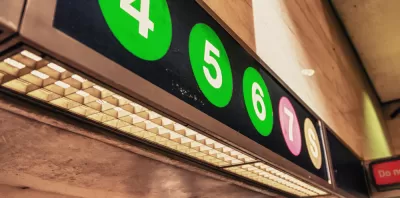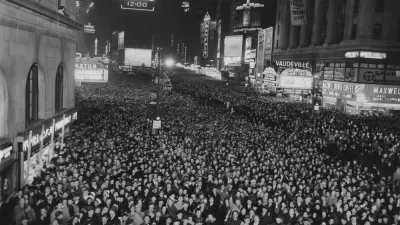As sky-high real estate prices force many lower-income New Yorkers to the periphery, they're paying an additional price in lengthy transit commutes. Meanwhile, real estate interests that benefit from transit investment bear few of its costs.

While negative stories on New York's transit system often focus on dramatic incidents, Jim Dwyer writes, the real problem is less picturesque. For many lower-income users, "The city's transit system controls everyday life [...] so insistently and so routinely that no one has thought to declare the situation a state of emergency."
Dwyer cites a 2013 study by the Pratt Center for Community Development and the Rockefeller Foundation indicating that "758,000 New York City residents now travel more than an hour each way to work, most of them to jobs that pay less than $35,000 per year." In addition, "Black New Yorkers' trips to work are 25 percent longer than whites, and Hispanics, 12 percent longer than whites, other research by the Pratt Center found."
Dwyer also points to the fact that despite New York transit's long-standing history of boosting nearby real estate, "none of the current proposals by the mayor or the governor for funding it touch on property values. That means the system captures none of the boom created by the new Second Avenue subway line on the Upper East Side of Manhattan."
FULL STORY: Pushing New Yorkers Beyond the End of the Line

Alabama: Trump Terminates Settlements for Black Communities Harmed By Raw Sewage
Trump deemed the landmark civil rights agreement “illegal DEI and environmental justice policy.”

Planetizen Federal Action Tracker
A weekly monitor of how Trump’s orders and actions are impacting planners and planning in America.

The 120 Year Old Tiny Home Villages That Sheltered San Francisco’s Earthquake Refugees
More than a century ago, San Francisco mobilized to house thousands of residents displaced by the 1906 earthquake. Could their strategy offer a model for the present?

In Both Crashes and Crime, Public Transportation is Far Safer than Driving
Contrary to popular assumptions, public transportation has far lower crash and crime rates than automobile travel. For safer communities, improve and encourage transit travel.

Report: Zoning Reforms Should Complement Nashville’s Ambitious Transit Plan
Without reform, restrictive zoning codes will limit the impact of the city’s planned transit expansion and could exclude some of the residents who depend on transit the most.

Judge Orders Release of Frozen IRA, IIJA Funding
The decision is a victory for environmental groups who charged that freezing funds for critical infrastructure and disaster response programs caused “real and irreparable harm” to communities.
Urban Design for Planners 1: Software Tools
This six-course series explores essential urban design concepts using open source software and equips planners with the tools they need to participate fully in the urban design process.
Planning for Universal Design
Learn the tools for implementing Universal Design in planning regulations.
Clanton & Associates, Inc.
Jessamine County Fiscal Court
Institute for Housing and Urban Development Studies (IHS)
City of Grandview
Harvard GSD Executive Education
Toledo-Lucas County Plan Commissions
Salt Lake City
NYU Wagner Graduate School of Public Service





























